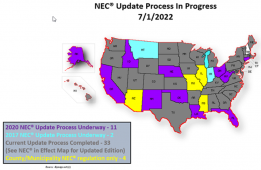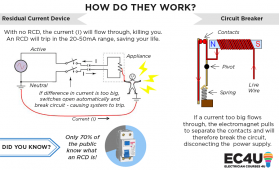You are using an out of date browser. It may not display this or other websites correctly.
You should upgrade or use an alternative browser.
You should upgrade or use an alternative browser.
Approved inverters & batteries - Inspection
- Thread starter ohsolar
- Start date
Submit the product spec docs with your plans to your local ahj for review before you purchase anything. Include the product numbers and specs in the plans you submit for approval. List the inverters etc...by name and model , instead of just a box drawn on the plan that says "5k inverter" it should be the specific brand and model number.
If the ahj approves your plans without revision , then that is exactly what is approved for use. If the local inspector has any issue you can refer to your "approved for construction " drawings from the local ahj.
Approved construction plans/ specs are considered legal docs in most places.
If the ahj approves your plans without revision , then that is exactly what is approved for use. If the local inspector has any issue you can refer to your "approved for construction " drawings from the local ahj.
Approved construction plans/ specs are considered legal docs in most places.
EJansen
Solar Enthusiast
UL Listed and NEC compliant are two different things. I bought twoEG4 6500s and after attempting to make my setup code compliant I learned a lot about it. I learned that it has no ground fault protection, it has no arc fault protection, and if you have a battery bank connected it will back feed power to your panels. So even if you have a rapid shutdown solution to kill power at the panels, if you have batteries feeding the inverter, it will feed back. I know because I learned the hard way by getting shocked while on the roof. Not saying you couldn't pass an inspection, but you'd need 3rd party solutions for Arc Fault, Ground Fault, and RSD (depending on where you live and if they follow 2017 and later guidance).
I'm struggling to find good 3rd party solutions for ground fault and arc fault protection, but I think the solid-state relays that I bought will work for cutting power between the inverter and panels to at least meet the RSD requirement.
I'm struggling to find good 3rd party solutions for ground fault and arc fault protection, but I think the solid-state relays that I bought will work for cutting power between the inverter and panels to at least meet the RSD requirement.
Last edited:
Solar Guppy
Red Cobra Guppy
Neither of those inverters will work for NEC2017 or newer locations in the US to meet codes, the sellers are intentionally vague to push the hardware on DYI that don't know what to look for.
If it isn't UL1741SA ( inverters ) or UL9540 for battery / inverter pairing ( storage systems ), it won't pass current codes. Keep in mind many locations are one or two versions behind the current NEC codes, but it won't be too long that the most the US will be NEC2020 or newer
You can see the current map HERE


If it isn't UL1741SA ( inverters ) or UL9540 for battery / inverter pairing ( storage systems ), it won't pass current codes. Keep in mind many locations are one or two versions behind the current NEC codes, but it won't be too long that the most the US will be NEC2020 or newer
You can see the current map HERE


Neither of those inverters will work for NEC2017 or newer locations in the US to meet codes, the sellers are intentionally vague to push the hardware on DYI that don't know what to look for.
If it isn't UL1741SA ( inverters ) or UL9540 for battery / inverter pairing ( storage systems ), it won't pass current codes. Keep in mind many locations are one or two versions behind the current NEC codes, but it won't be too long that the most the US will be NEC2020 or newer
You can see the current map HERE
View attachment 109313
View attachment 109314
Neither of those inverters will work for NEC2017 or newer locations in the US to meet codes, the sellers are intentionally vague to push the hardware on DYI that don't know what to look for.
unfortunately, this is sadly so very very true.
however.... a way to "get around" most all of this is to use a ground mount array. it's really all about fire prevention for panels on a residential roof. no local AHJ inspector that knows anything about solar is going to require RSD or AFCI for a ground-mount array. it simply makes no sense whatsoever.
EJansen
Solar Enthusiast
Thanks for the info all. What is RSD @EJansen ? (newbie here). I won't have PV in my system. Just batteries for peak hour savings
Haven't caught up on the thread yet to see if someone already answered, but RSD is Rapid Shut Down. For 2017 and later NEC you're supposed to have per panel shutdown modules, like the TIGOs that I use, but depending on the inverter that's only one side of the mix. For the EG4s, you'll have to find some custom solution for preventing back feed to the roof from the inverters.
EJansen
Solar Enthusiast
The best option, in my opinion, is to get a Sol-Ark if you're going to do a roof top array and want to get an inspection. They're somewhat pricey though. The cheaper option was to get a Deye, since they make Sol-Arks, and you could get them for like 25% of what they were asking for a Sol-Ark, but you can't get them anymore as of recently if I recall correctly. @FilterGuy would know for sure as he used to / still sells them and other solar products?hmm..thank you..do you have any suggestions that are not too expensive?
Mike 134
Solar Enthusiast
Just an FYI you need devices that trip at 5 Milli amps to protect life. They charging you for this misinformation?
715 Electrical Safety for Technicians and Supervisors
715 Electrical Safety for Technicians and Supervisors - Course Introduction
EJansen
Solar Enthusiast
Thanks for the info all. What is RSD @EJansen ? (newbie here). I won't have PV in my system. Just batteries for peak hour savings
Aah ok, so you're just trying to do a time of use configuration. In that case, you might even consider going the EcoFlow route using some EcoFlow Delta Pros and a Smart Home Panel.
FilterGuy
Solar Engineering Consultant - EG4 and Consumers
Nope....I have never sold a solar product of any kind.@FilterGuy would know for sure as he used to / still sells them and other solar products?
EJansen
Solar Enthusiast
Ah, then I was just kidding / misinformed.Nope....I have never sold a solar product of any kind.
Update - yeah, just went to my mail conversations from over a year ago - and I confused you with another member on here - sorry about that.
Last edited:
FilterGuy
Solar Engineering Consultant - EG4 and Consumers
The linked image you are referring to is correct in many ways and perhaps misleading in other ways. The image is almost certainly not from a US/North American and was referring to an RCD (Not a GFCI). (Even the picture is a typical RCD) While similar to the GFCI (Ground Fault Current Interrupt), an RCD (Residual Current Device) was originally developed for a different need.Just an FYI you need devices that trip at 5 Milli amps to protect life. They charging you for this misinformation?
715 Electrical Safety for Technicians and Supervisors
715 Electrical Safety for Technicians and Supervisors - Course Introductionwww.oshatrain.org
In the US, we call them GFI or GFCI and they trip in the 5-7mA range. The purpose of these devices is to interrupt a current flowing through a person.
In most of the rest of the world, they have RCD (Residual Current Disconnect(?)) devices that typically trip in the 25mA-50mA range. I read once that RCDs were originally developed for grid systems that do not use a Neutral-Ground bond and therefore would not immediately clear a ground fault. (At the time, 25ma-50ma was about as good as they could do at a reasonable price but that was all that was needed for clearing ground faults) They are now commonly seen in all types of grid configurations.
Having said all of that, You are correct. 25mA can give you a hell of a jolt and 50mA is getting well into the danger zone. However, I have no doubt that the RCDs seen throughout Europe have saved lives when a human was the electrical path. Consequently, I would not go as far as calling it misinformation.
FilterGuy
Solar Engineering Consultant - EG4 and Consumers
No problem..... I can be very confusing!!Ah, then I was just kidding / misinformed.
Update - yeah, just went to my mail conversations from over a year ago - and I confused you with another member on here - sorry about that.
Hedges
I See Electromagnetic Fields!
- Joined
- Mar 28, 2020
- Messages
- 21,303
got it..
"Only 70% of the public know what an RCD is!"
(I think they are being generous.)

Study finds Americans are the most stupid people on the planet - Ozzie News
Every country on earth has its stupid people. But a recent Rand study examining 160 countries concludes America now has the highest percentage of stupid
ozzienews.com
SilverbackMP
Solar Addict
- Joined
- Apr 4, 2022
- Messages
- 988
God bless my state, freedom loving Missouri (but I'm buying quality stuff and and doing (most) things to standard (with the help of an electrician)).Neither of those inverters will work for NEC2017 or newer locations in the US to meet codes, the sellers are intentionally vague to push the hardware on DYI that don't know what to look for.
If it isn't UL1741SA ( inverters ) or UL9540 for battery / inverter pairing ( storage systems ), it won't pass current codes. Keep in mind many locations are one or two versions behind the current NEC codes, but it won't be too long that the most the US will be NEC2020 or newer
You can see the current map HERE
View attachment 109313
View attachment 109314
Similar threads
- Replies
- 75
- Views
- 6K
- Replies
- 8
- Views
- 388
- Replies
- 8
- Views
- 534
- Replies
- 2
- Views
- 481
- Replies
- 43
- Views
- 3K



